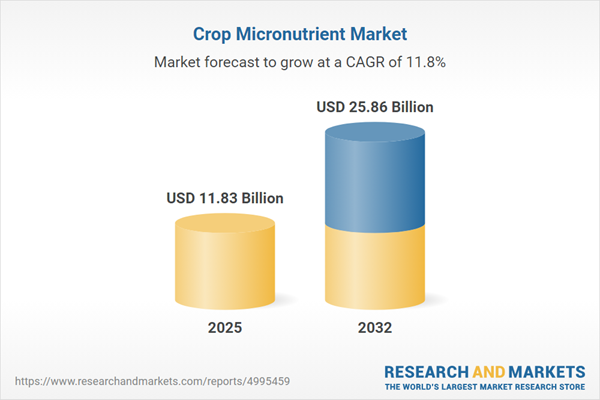Speak directly to the analyst to clarify any post sales queries you may have.
Senior decision-makers navigating global agriculture need targeted intelligence to stay ahead in the evolving crop micronutrient market. This report offers a comprehensive profile of current market forces, innovation drivers, and strategic segmentation to inform high-impact planning.
Market Snapshot: Crop Micronutrient Market Growth Trajectory
The Crop Micronutrient Market grew from USD 10.56 billion in 2024 to USD 11.83 billion in 2025. It is expected to continue growing at a CAGR of 11.83%, reaching USD 25.86 billion by 2032. This expansion is driven by demand for higher crop yields, the importance of nutrient efficiency, and the strategic adoption of advanced formulations across a spectrum of agricultural operations.
Scope & Segmentation: Understanding Competitive Differentiation
The report delivers actionable analysis, spanning essential segmentations, geographic coverage, and the latest technological advancements shaping value creation in the crop micronutrient space.
- Nutrient Types: Boron, Copper, Iron, Manganese, Molybdenum, Zinc
- Crop Types: Cereals & Grains (Maize, Rice, Wheat), Fruits & Vegetables (Apple, Potato, Tomato), Oilseeds & Pulses (Pea, Soybean, Sunflower), Turf & Ornamentals (Flower, Grass)
- Application Methods: Foliar, Seed Treatment, Soil
- Formulations: Chelated, Non-Chelated
- Distribution Channels: Offline, Online
- End-User Segments: Cooperatives & Dealers, Farms
- Geographic Regions: Americas (North America: United States, Canada, Mexico; Latin America: Brazil, Argentina, Chile, Colombia, Peru), Europe, Middle East & Africa (Europe, Middle East, Africa), Asia-Pacific (China, India, Japan, Australia, South Korea, Indonesia, Thailand, Malaysia, Singapore, Taiwan)
- Representative Companies: Yara International ASA, Nutrien Ltd., The Mosaic Company, EuroChem Group AG, Israel Chemicals Ltd., BASF SE, Coromandel International Limited, PhosAgro PJSC, Haifa Group, TIMAC Agro SA
Key Takeaways: Strategic Insights for Crop Micronutrient Market Leaders
- Regulatory changes and sustainability priorities are accelerating adoption of bio-based and eco-friendly micronutrient formulations.
- Technological innovations—such as chelation science and nano-scale delivery—are supporting more predictable nutrient uptake and improved crop resilience.
- A rise in data-driven agriculture is empowering growers to implement precise application strategies through digital tools and real-time analytics.
- Partnerships between agtech startups and established suppliers are shortening product development cycles and enhancing market responsiveness.
- Segment-specific practices, such as crop-type tailored solutions and regionally adapted blends, are key to market differentiation and sustained user engagement.
Tariff Impact: Navigating U.S. Trade Policy Shifts
Forthcoming changes in United States tariff policy are anticipated to impact global supply chains for crop micronutrient products and raw materials. Distributors and manufacturers are exploring alternative sourcing and bolstering domestic production to navigate increased duties and supply volatility. Adjustments in logistics, inventory strategies, and compliance initiatives are similarly underway to maintain efficient market access and mitigate risk exposure.
Methodology & Data Sources: Comprehensive, Rigorously Validated Insights
This report integrates structured interviews with industry experts, quantitative surveys of distributors and growers, and exhaustive analysis of scientific, governmental, and industry publications. Insights are triangulated across primary and secondary data streams, and the methodology is peer-reviewed for quality, enabling robust, objective conclusions for the crop micronutrient market.
Why This Report Matters: Decision Clarity for Crop Micronutrient Strategy
- Provides actionable intelligence for investment in next-generation products, agile sourcing, and compliance with evolving regulatory standards.
- Enables strategic alignment by mapping innovation hot spots, segment opportunities, and regional adoption patterns, supporting competitive portfolio expansion.
Conclusion
With forward-focused analysis and segment-specific insights, this report equips senior leaders to capitalize on emerging growth opportunities, mitigate operational risks, and drive sustainable progress in the crop micronutrient sector.
Additional Product Information:
- Purchase of this report includes 1 year online access with quarterly updates.
- This report can be updated on request. Please contact our Customer Experience team using the Ask a Question widget on our website.
Table of Contents
3. Executive Summary
4. Market Overview
7. Cumulative Impact of Artificial Intelligence 2025
Companies Mentioned
The companies profiled in this Crop Micronutrient market report include:- Yara International ASA
- Nutrien Ltd.
- The Mosaic Company
- EuroChem Group AG
- Israel Chemicals Ltd.
- BASF SE
- Coromandel International Limited
- PhosAgro PJSC
- Haifa Group
- TIMAC Agro SA
Table Information
| Report Attribute | Details |
|---|---|
| No. of Pages | 181 |
| Published | October 2025 |
| Forecast Period | 2025 - 2032 |
| Estimated Market Value ( USD | $ 11.83 Billion |
| Forecasted Market Value ( USD | $ 25.86 Billion |
| Compound Annual Growth Rate | 11.8% |
| Regions Covered | Global |
| No. of Companies Mentioned | 11 |









